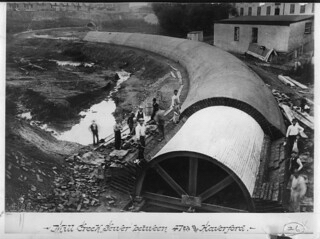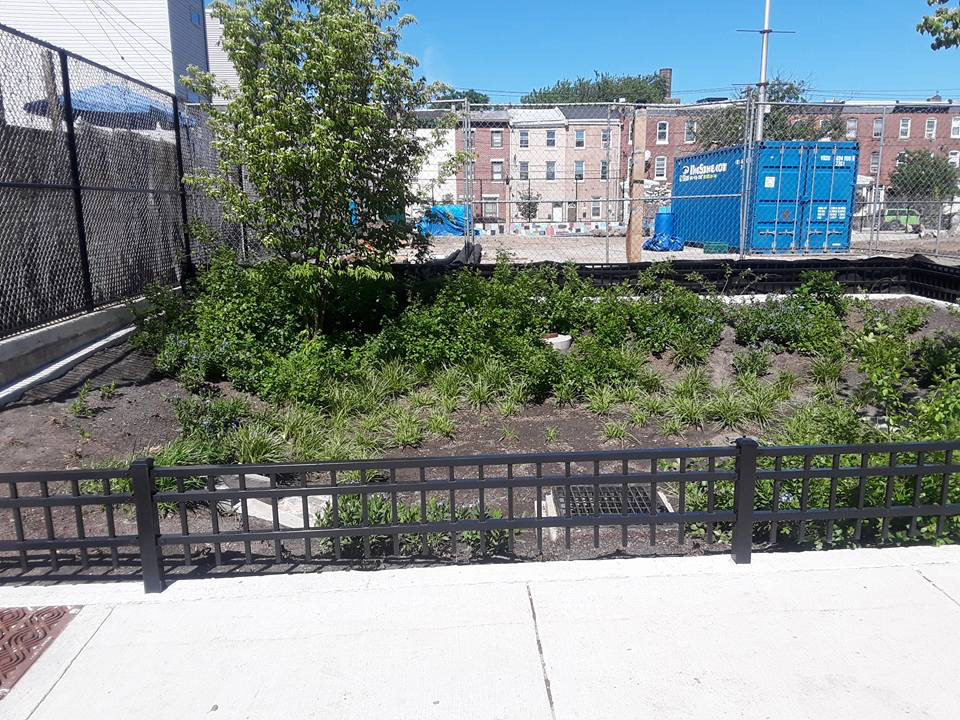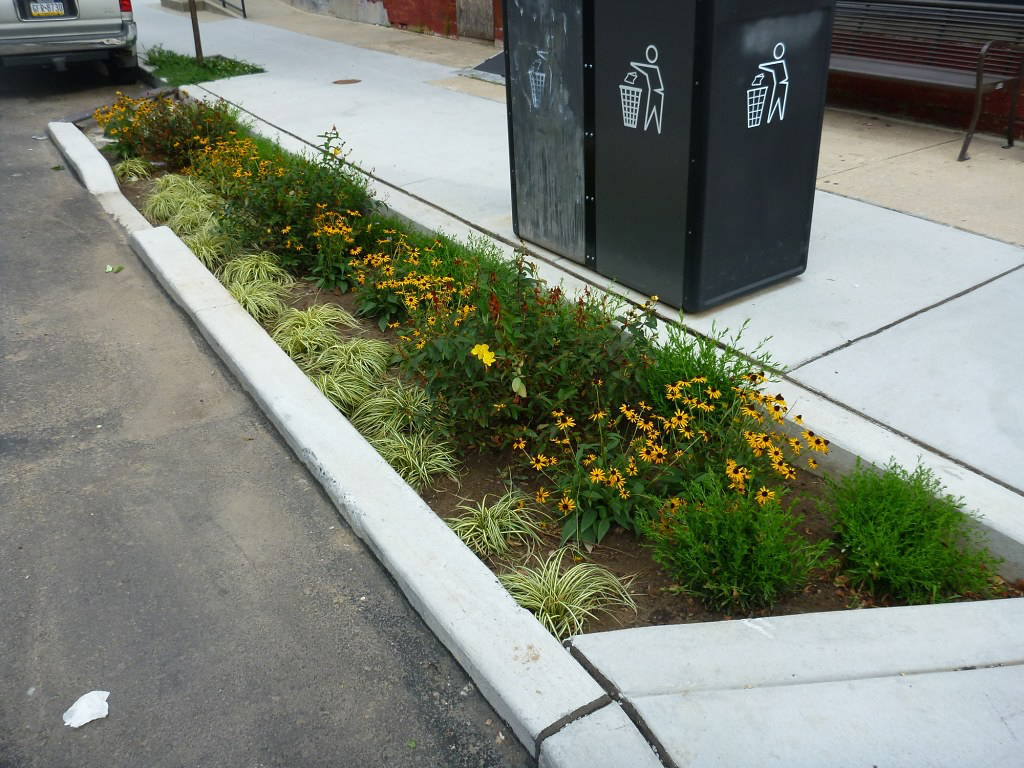
Here's a shot of one of PWD's stormwater planters. (Photo courtesy of the Philadelphia Water Department)
Interested in Infrastructure?
Get Infrastructure articles, news and videos right in your inbox! Sign up now.
Infrastructure + Get AlertsA significant problem for many municipalities is combined sewer overflows (CSOs). Now, imagine the scale of the problem when your streams are your sewers. That’s the problem the Philadelphia Water Department (PWD) is dealing with today, but first, how did they end up here?
Long before the city was covered with streets, sidewalks and skyscrapers, it was nothing but rolling hills, farmland, forest and streams as far as the eye could see — a lot of streams. Like all developing cities, that land became less pristine as the population grew, and its creeks became the convenient receptacle for just about anything anyone wanted to get rid of, including sewage, slaughterhouse refuse and industrial waste.
Not only were the creeks becoming sewers, but they also stood in the way of development. During the mid-1800s, Philadelphia engineers tackled both problems by culverting the streams. One could say it was an out of sight, out of mind approach.
By the early 1900s however, people started realizing that dumping sewage and other waste into the rivers was unsustainable, so Philadelphia began a project to divert all those filthy creeks into sewage treatment plants. These creeks became Combined Sewer Systems (CSS) that would only release directly into Philadelphia’s two main waterways during particularly heavy rain. It has operated that way for the last 100 years or so, and will continue to work that way for the foreseeable future.

This is one of the city's early creek culverts. (Photo courtesy of the Philadelphia Water Department)
Today the Philadelphia Water Department (PWD) is responsible for approximately 3,000 miles of sewer, 79,000 stormwater inlets, three drinking water treatment plants, three wastewater treatment plants, more than 25 pump stations, 175 CSO regulating chambers, 164 CSO outfalls, more than 3,000 miles of water mains, and more than 450 stormwater outfalls. The estimated annual CSO discharge is at about 16 billion gallons from 164 CSO point sources.
While many cities and towns have to deal with CSO events, PWD not only has to deal with rainwater runoff from buildings and streets, but naturally swelling streams as well. While the city does have a fair amount of green space in the CSS areas, developers are building on every square foot available, meaning there is little private green space and even more runoff with nowhere to go but into the CSS. To put it simply, Philadelphia needs to absorb more of its rainfall into the land instead of into the sewers, and they have a plan to do just that.
In 2011 the city launched its 25-year plan called the Green City, Clean Waters initiative. By the close of the 25-year implementation period, according to the PWD, they had originally planned to invest approximately $2.4 billion to initiate the most extensive green stormwater infrastructure program ever envisioned in this country. While the ultimate goal is to improve water quality, CSO rates are too variable to use as a measure of success.
Instead, they measure success through the achievement of what PWD refers to as a Greened Acre. Joanne Dahme, general manager of public affairs for PWD, says the city’s Greened Acres represent the transformation of impervious areas in its combined sewer areas to pervious ones. “Every Greened Acre captures the first one and a half inch of stormwater runoff in a drainage area the size of an acre.” They are currently on track to meet their first 10-year milestone.
Civic and community engagement
To find the best potential sites to help meet their Greened Acre milestones, Dahme says the department identified public spaces such as playgrounds, recreation centers, parks and schools suited to the project. PWD is also adding green structures such as rain gardens, bump-outs and tree trenches to sidewalks and streets. Part of that identification process involves working with various city agencies and communities to allow PWD to retrofit properties to build green stormwater infrastructure.
Both during the planning phase and when the PWD went live with its Green City, Clean Waters initiative in 2011, Dahme says the department did a significant amount of engagement and outreach with city partners — and also with the public. Because it was the first time the water department was looking to build infrastructure above ground versus below, they needed to ensure people understood what they were talking about.
“We weren’t known as the green entity, or the entity that would be putting rain gardens in versus a new sewer. So, we had to change that mindset,” says Dahme.
One such example of a retrofit and interagency cooperation is the Hagert Playground in Philadelphia’s Kensington neighborhood. What was once a concrete desert is now a vibrant part of the community. Julius Rivera, founder of the community group Friends of Hagert Playground, says that initially, the PWD had looked at Hagert Playground as a potential Greened Acre site.
“Because the playground was in such disarray, PWD didn’t want to move forward with adding to it because they felt that if they started doing the project, the rest of the playground would fall apart around them while they were trying to add their element to it,” says Rivera.
Around the same time the PWD eliminated the Hagert Playground site for improvement, the East Kensington Neighbors Association jumped in and applied for a grant to make improvements to the playground. Ultimately, a new playground design was created by the Community Design Collaborative in partnership with the Friends of Hagert Playground, which got the stamp of approval from the city’s Parks and Recreation Department.
Rivera says stormwater runoff was always an important consideration during the design process, and PWD also approved the collaborative’s ideas of how to deal with it and the new-and-improved Hagert Street Playground — now a Greened Acre site. Two rainwater gardens sit at each end of the playground. Not only do the gardens capture runoff from the playground, but street runoff is also directed into the gardens.
As you can see from the above example, with even a small project like the playground, there are many different organizations, community groups and city departments involved, and Dahme says community engagement is key to the success of any individual project.
Implementation of the projects that are part of the Green City, Clean Waters program can last as long as five years, and PWD is continually going back to the community during the design and planning phase, pre-construction, construction, and then after the project for maintenance. To reach as many people as possible, they meet with leaders of civic and neighborhood groups to ensure they always have the most up-to-date information on the project to pass along to the community.
Tiffany Ledesma, public engagement team leader for PWD — who is a contract employee with CDM Smith, but has spent 15 years working in-house at PWD — says the department also solicits feedback on design in some cases.
“The water department already has a very clear sense of what infrastructure is needed to make sure that we’re meeting our goals,” she says. “But there could be a little bit of wiggle room, and that’s where we can get good feedback from the community.” That wiggle room might be a preference for a rain garden versus a stormwater tree, or yellow flowers versus pink flowers.
According to Ledesma, in addition to attending community meetings, PWD also uses a variety of tools such as social media, robocalls, and even paint days to communicate directly with the public.
Overcoming challenges
Despite the amount of community engagement on projects, you can’t please everyone, and when Philadelphians don’t like something, they’ll let you know. Stormwater bump-outs — a vegetated curb extension that protrudes into the street — can be a particularly contentious issue according to Ledesma, because they impact parking. Never mind that the bump-outs are constructed in illegal parking spaces.
Another subject that gets neighbors’ hackles up is maintenance. Ledesma says people want to know if they are going to have to clean up the leaves from a tree planted by PWD or if they will have to maintain the rainwater gardens. (The answer is no, the PWD is responsible for maintaining the area.) So, a fair amount of time is spent managing the public’s expectations.
However, there are far more significant issues than raking leaves and parking wars that the PWD is working through. “I think the plan is harder to implement than we thought, and mostly because of the cost,” says Dahme. “We didn’t have a set of designs we could just pull off the shelf.”
She explains that the infrastructure has to be designed uniquely to the situation where it’s being installed. Now, PWD is attempting to create design templates for re-occurring cases.
“We were really, really conservative when we started. We wanted to ensure that we didn’t cause any flooding to any property or cause any problems,” says Dahme. While PWD does exchange ideas with other utilities and municipalities all the time, Dahme explains they were the first to do something like this at the scale they are doing it, so they didn’t have anyone to share advice or lessons learned.
“It would’ve been hard for us not to do it the way we did it because we were one of the first and so we did have to be the innovator, and we didn’t have much of a choice about that,” says Dahme.
What has been a challenge for Philadelphia doesn’t have to be for other municipalities looking to implement a similar program. Ledesma says they get utilities and government representatives from all over the United States and abroad coming to Philadelphia to see what PWD is doing. The water department doesn’t just accommodate these requests; they encourage them. If you are interested in learning more about the Green City, Clean Waters initiative, you can visit the website, and if what you see inspires you, you can request a tour.







